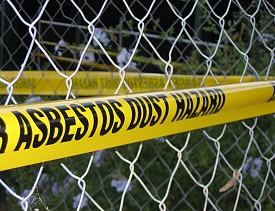Roofing: Asbestos Removal Costs
 No one would consider using a material that contains asbestos today. Back in the 1930s to the 1970s, though, asbestos was considered practical -- even desirable -- due to its great fire resistance and fibrous strength characteristics. Roofing and siding are some of the most common materials from that era that contain asbestos.
No one would consider using a material that contains asbestos today. Back in the 1930s to the 1970s, though, asbestos was considered practical -- even desirable -- due to its great fire resistance and fibrous strength characteristics. Roofing and siding are some of the most common materials from that era that contain asbestos.
If it is not “broken,” don’t fix it.
The mantra for most asbestos-containing materials is "Leave it alone." The asbestos is normally sealed in the matrix of the component, and thus contained does not pose a health risk. Only when the material is disturbed does it become a problem.
In that case, there are two primary paths: repair or removal. The first and simplest is repair, which can be accomplished by sealing or covering.
- Sealing (encapsulation) involves application of a sealant that either binds the asbestos fibers together or coats the material so that asbestos fibers are not released.
- Covering (enclosure) involves placing something over or around the material to prevent release of asbestos fibers.
Removing asbestos is the most costly solution and unless required by state or local regulations, should be the last option considered in most situations.
How much does asbestos removal cost?
Asbestos removal cost varies by region. Since this tends to be a costly project, the first step is to ensure you actually have asbestos. This is normally done with samples and testing. On-site testing can run from $250-1000 with additional costs of $500-1000 for “real time” air quality monitoring. Alternatively, a sample can be sent to testing facilities for analysis at a lower cost.
Once removal is slated, there are usually 3 phases:
- preparation work, where contractors “prep” the area using HEPA vacuums. This cost can run about $40 a sq. foot.
- removal phase, the actual physical removal, at a cost of $15-25 a sq. ft. (Encapsulation, by comparison, can range from about $3-6 per sq. ft.)
- regulated disposal phase
Who can do the work?
While some regulations allow single family homeowners to undertake this type of project on their own, usually you must hire a licensed contractor for this type of work. It is required for projects that involve public buildings, like schools, or structures that contain 4 or more residences. Find a team that is versed in the complex nature of dealing with this potentially hazardous material. A specialist that performs these abatements for a living should be very familiar with the local regulations (which vary widely) and all the special requirements for a safe and productive process.
Updated January 21, 2018.
Looking for a Pro? Call us (866) 441-6648

Roofing Average Costs
Roofers Experiences

Cement Tile Roof Repair Took Some Detective Work

My Roof Replacement Was Simply Outstanding



